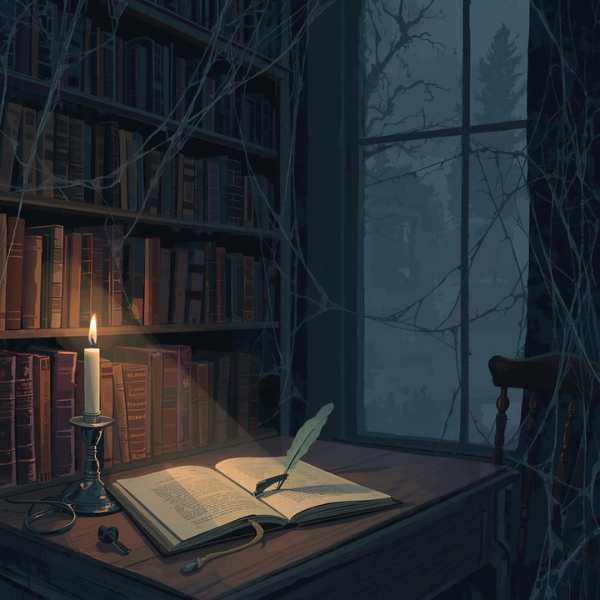
When the leaves turn orange, the air chills, and the veil between worlds grows thin, Halloween takes center stage — not just in costumes and candy, but in literature. The holiday’s dark allure has long inspired British writers, who transformed ancient Celtic traditions and ghostly folklore into timeless stories of fear, mystery, and imagination.
From the eerie superstitions of Samhain, to Shakespeare’s witches, to the haunting pages of Mary Shelley’s Frankenstein and Bram Stoker’s Dracula, British literature played a crucial role in shaping how we imagine horror. This is the story of how Halloween — born from pagan ritual — evolved into a rich literary tradition of terror that still influences novels, films, and pop culture today.
🍂 1. From Samhain to Storytelling: Celtic Roots of British Horror
Long before Halloween became a night of costumes and jack-o’-lanterns, it was Samhain, the ancient Celtic festival marking the end of harvest and the beginning of winter.
🔥 A Night Between Worlds
Samhain, celebrated in Britain and Ireland over 2,000 years ago, was believed to be a time when spirits and ancestors returned to the living world. Bonfires were lit to ward off evil, people wore masks to confuse wandering ghosts, and offerings of food were left for the dead — practices that later transformed into Halloween traditions.
But these beliefs did more than shape rituals — they shaped stories. Early Celtic myths, preserved in medieval manuscripts like the Mabinogion or Book of Invasions, introduced motifs that would echo through British literature:
- The thin veil between life and death
- Supernatural creatures like banshees, fairies, and shape-shifters
- Prophecies, omens, and cursed places
These legends planted the seeds of British Gothic literature, where the natural and supernatural coexist uneasily — a concept that fascinated writers from Shakespeare to the Victorians.
⚡ 2. Shakespeare and the Supernatural Stage
By the late 16th century, the eerie imagination of Celtic folklore found new life in the works of William Shakespeare. His plays reveal how deeply Renaissance England was still haunted by superstitions, witchcraft, and ghosts.
👻 The Witches of Macbeth
Perhaps the most iconic Halloween-like scene in English literature appears in Macbeth (1606). The “weird sisters,” chanting “Double, double toil and trouble; Fire burn and cauldron bubble”, embody everything we associate with the witching hour — dark magic, fate, and foreboding.
Their bubbling cauldron and sinister prophecies symbolize how people in Shakespeare’s time feared the unknown, yet were irresistibly drawn to it. King James I himself had published Daemonologie (1597), a treatise on witchcraft — proving how real the supernatural seemed in that era.
💀 Ghosts and Guilt in Hamlet
Shakespeare also immortalized the revenant, or vengeful ghost. The specter of King Hamlet — demanding justice from beyond the grave — created a model for countless literary hauntings to come.
In Shakespeare’s hands, ghosts were not just scary; they were psychological mirrors, exposing guilt, ambition, and moral decay. This blending of the spiritual and emotional became a key trait of British Gothic writing.
🌕 3. The Rise of the Gothic: Fear Becomes an Art
By the 18th century, Britain was gripped by a fascination with ruins, darkness, and the supernatural. The Gothic novel was born — the literary ancestor of modern horror.
🏰 Horace Walpole and The Castle of Otranto
In 1764, Horace Walpole published The Castle of Otranto, considered the first Gothic novel. Set in a haunted Italian castle, it introduced classic tropes that would define the genre:
- Ancient curses
- Secret passages
- Mysterious prophecies
- Ghostly apparitions
Although Walpole’s story was more melodramatic than terrifying, it created a blueprint that later authors expanded into darker, more psychological tales.
🌑 Ann Radcliffe and the Power of Imagination
Radcliffe’s novels, especially The Mysteries of Udolpho (1794), added sophistication to Gothic fiction. She mastered the art of “explained supernatural” — giving rational explanations for apparently ghostly events, while still maintaining suspense.
Her heroines, trapped in gloomy castles and facing unseen threats, symbolized the tension between reason and imagination, a theme that reflected Enlightenment-era fears of losing control to superstition.
🧛♂️ 4. Romanticism and the Birth of the Modern Monster
By the early 19th century, British writers began merging Gothic terror with Romantic emotion. Horror became not just external — a ghost in a castle — but internal, rooted in the human psyche.
⚡ Mary Shelley and Frankenstein (1818)
No author captured this shift better than Mary Shelley. At just 18 years old, she wrote Frankenstein; or, The Modern Prometheus — a novel born from a ghost story contest during a stormy night in Switzerland.
Shelley’s creature was not a supernatural being from folklore, but the product of scientific ambition and human hubris. This made Frankenstein revolutionary: it turned horror into a moral and philosophical exploration.
Her creation story — with lightning, graveyards, and the desire to play God — reflected deep anxieties about progress and mortality. The novel’s lasting influence is clear every Halloween, when Frankenstein’s monster still walks among us in costumes, films, and art.
🌘 Polidori and the Birth of the Vampire
The same ghost-story competition also gave rise to another icon: John Polidori’s The Vampyre (1819). Inspired by Lord Byron, Polidori’s elegant but predatory vampire transformed the blood-drinking creature of Eastern European legend into a symbol of seduction and power.
This figure would later evolve in Bram Stoker’s Dracula, cementing the vampire as one of Halloween’s greatest literary creations.
🦇 5. The Victorian Obsession: Ghosts, Guilt, and Gothic Revival
The Victorian era (1837–1901) marked the golden age of the ghost story. Advances in science, industry, and psychology collided with spiritualism and superstition, creating fertile ground for eerie imagination.
👻 Charles Dickens and the Morality of Ghosts
While best known for A Christmas Carol (1843), Charles Dickens was fascinated by the supernatural. His ghosts were moral teachers — not monsters. The spirits of Marley and the Christmases Past, Present, and Yet to Come force Scrooge to confront his soul.
Dickens also edited and contributed to several collections of Victorian ghost stories, helping popularize the genre among middle-class readers who read such tales aloud by the fireside.
🏰 The Female Gothic: Women and the Haunted Mind
Writers like Charlotte Brontë (Jane Eyre, 1847) and Emily Brontë (Wuthering Heights, 1847) brought a psychological and emotional depth to Gothic themes. Their isolated settings, spectral presences, and stormy atmospheres turned haunted houses into metaphors for repressed desire and madness.
The mysterious laughter of Bertha Mason in Jane Eyre or the ghostly passion of Catherine Earnshaw in Wuthering Heights blurred the line between the supernatural and the psychological — a hallmark of later horror fiction.
🧛 Bram Stoker’s Dracula (1897): The Eternal Halloween Icon
When Bram Stoker published Dracula, he synthesized centuries of myth — Celtic, Christian, and folkloric — into the definitive vampire tale.
The Count embodied multiple fears of Victorian Britain:
- The invasion of the foreign and unknown
- Sexual repression and temptation
- The tension between science and superstition
Set against the gloomy backdrop of Transylvanian castles and foggy London streets, Dracula captured both the mystery of the past and the anxieties of modernity.
Without Dracula, Halloween as we know it — with bats, vampires, and Gothic imagery — would look very different.
💀 6. Folklore Lives On: From Victorian Tales to Modern Culture
As the 20th century dawned, the Gothic didn’t die — it evolved. British authors and artists continued to reinterpret the old motifs of witches, ghosts, and cursed houses through new cultural lenses.
- M.R. James, a Cambridge scholar, wrote sophisticated ghost stories (Oh, Whistle, and I’ll Come to You, My Lad, 1904) that returned to the classic formula of cursed manuscripts and ancient evils.
- Daphne du Maurier’s Rebecca (1938) modernized the haunted mansion, replacing literal ghosts with the haunting memory of a woman.
- Modern British horror — from film studios like Hammer to writers such as Susan Hill (The Woman in Black) — carried forward the tradition of atmospheric fear rooted in literary Gothic.
Even today, series like Penny Dreadful and Doctor Who, and authors like Neil Gaiman, keep this lineage alive, fusing folklore, Gothic, and modern psychology.
🎃 7. The Gothic Legacy in Today’s Halloween
When you carve a pumpkin, read a ghost story, or watch a horror movie on October 31, you’re participating in a literary tradition centuries old.
British literature didn’t just reflect Halloween — it created its imagination:
- The witches’ brew of Macbeth
- The creature of Frankenstein
- The vampire of Dracula
- The haunted mansions of the Brontës and Dickens
Together, they turned death and darkness into art, emotion, and reflection.
Halloween, once a night of fear, became a celebration of storytelling — proof that the things that scare us most can also fascinate and connect us.
🕯️ Conclusion: From Folklore Fires to the Page
From Celtic druids gathered around sacred fires to Victorian readers huddled by candlelight, the British have long used stories to confront the unknown. Halloween in British literature is not merely about ghosts or monsters — it’s about the imagination’s power to transform fear into meaning.
Whether through the tragic ambition of Macbeth, the lonely terror of Frankenstein’s monster, or the seductive menace of Dracula, each work invites us to ask: Why do we fear — and why can’t we look away?
So this Halloween, as you light a candle or open a spooky book, remember: the darkness you feel has been centuries in the making — whispered first by Celtic bards, written by Shakespeare’s quill, and immortalized by Victorian pens.
📚 Sources
- The British Library – Gothic Literature: A Beginner’s Guide
- National Trust UK – The Origins of Halloween and Samhain in Britain
- Oxford University Press – The Cambridge Companion to Gothic Fiction
- BBC Culture – Why Mary Shelley’s Frankenstein Still Haunts Us
- Historic UK – Witches, Ghosts, and the Gothic Tradition
- The Guardian – The Enduring Power of the Victorian Ghost Story
- Folklore Society – Celtic Myths and the Birth of Gothic Imagination

